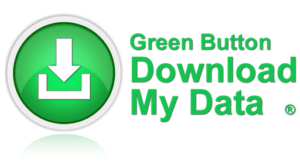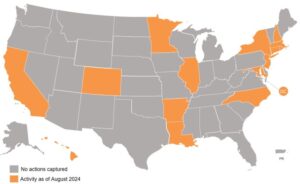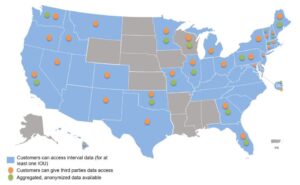Smart Meters, Smart Policies: Accessing and Using Energy Data
By: Vincent Potter, Senior Policy Analyst
Advanced metering infrastructure (AMI) is a network of smart utility meters, communications methods and protocols, and data management systems that aim to capitalize on the capabilities of new metering technologies for broad benefits. While utilities receive direct benefit in labor costs from remotely read and managed meters, many of the benefits come from being able to access the outputs of the meters, especially because smart meter data can be gathered at shorter time periods than manually read meters. Depending on configuration, smart meters can report energy use in real time or at other intervals such as every 15 minutes or every hour.
Energy usage data is important to the design of demand response, energy efficiency, and energy management programs. When utilities develop these programs, data access is not typically an issue because the utilities are already custodians of the data that is gathered by the meters in the company’s fleet. However, third parties also develop programs that benefit from energy data access. State agencies and community-based organizations implement weatherization programs, and energy services companies can operate aggregated demand response or distributed energy programs on behalf of utilities or to participate in energy markets. Architecture and engineering companies analyze energy data during energy audits to determine opportunities for optimization of energy use.
When outside entities need access to data to implement goals, there are concerns about protecting customer privacy and utility operations. Policymakers can step in and set the ground rules for sharing data to ensure that energy data is not used in a harmful way. For example, residential customer data could reveal occupancy patterns or other personal information, or large industrial energy usage information could reveal operation profiles and production capacity. Protecting customers can mean limiting data sharing to only trusted partners or limiting the amount of data shared, sometimes both. Legislation enacted last year in Minnesota requires that customers provide written consent before their data is shared. However, aggregated data sharing is allowed without permission if individual customers are not identifiable.
The popularity of virtual power plants (VPPs) has increased the attention on data access rules and regulations. VPPs are combinations of existing technologies, demand response and distributed generation resources, aggregated by utilities or third parties, to provide the desired services for the grid. VPPs can consist of quickly responding generation, rapid load shedding, distributed resources, or some combination thereof. In order to prove that operations were successful, frequent measurements of energy use are needed. Third parties that aggregate resources and/or provide VPP operations for utilities or electricity markets need reliable meter data for optimal provision of their services.
Data Needs in Federal Programs
Several federal programs require access to customer energy data to achieve their goals. State agencies and regulators have launched some investigations into the impact of data access rules on federal grant opportunities. Many federal grant programs have data requirements to show progress toward goals. Processes to access energy usage data can make compliance reporting on grant projects simpler and, potentially, improve the likelihood of achieving project goals by having secure, ready access to needed energy data.
The Environmental Protection Agency’s (EPA’s) Solar For All (SFA) program requires awardees to measure and track the energy savings for beneficiaries. The SFA program requires verification and validation that customers experience 20% bill savings; having a seamless and straightforward way to verify their energy savings would smooth program operations. Similarly, SFA programs in various states may need to gather customer information prior to any work being done to ensure that systems are designed with enough capacity to achieve the savings required by the EPA.
Several other governmental programs rely on energy data access to achieve program goals, such as the Onsite Energy Technical Assistance Partnership (formerly the Combined Heat and Power Technical Assistance Partnership) from the Department of Energy. The Technical Assistance Partnership (TAP) works with large customers like industrial facilities to identify opportunities to reduce energy use, improve efficiency, and provide cost savings. Much of the savings comes from peak demand reductions and load shifting rather than absolute energy reductions. Technical assistance requires up-to-date energy data with as narrow of an interval as possible. Downloading customer bills can provide some of this data, but very granular datasets, such as 15-minute interval data, allow for more accurate models and recommendations for partners.
The Climate Pollution Reduction Grants (CPRG) offered by the U.S. EPA are a multiphase grant program for entities to create plans and implement greenhouse gas (GHG) emission reductions in their region, state, or area. To get the best and most accurate results, the EPA requires a GHG inventory of current emissions from the affected area, and periodic measurements of changes resulting from implementation of the plans. A GHG inventory requires accurate measurements of the energy consumed within an area, as well as the emissions related to producing that energy. For electricity and gas, much of this data is maintained by utilities. Federal regulations require that utilities report energy consumption, productions, and emissions for their entire service territory.
Some instances of the action plans within the CPRG program do not cover an entire utility service territory. This can create a barrier for data access with its own issues. Action plans do not target individual homes or businesses, but areas overall, so these plans do not benefit from Green Button or similar sharing platforms. Aggregated energy data is needed to get the full picture of energy use within an area, but sometimes there is no direct mechanism for sharing this data, or even requesting it. This leads to agencies trying to implement GHG reduction programs to have to step into the regulatory realm of utilities commissions – somewhere that many community organizations and state energy offices do not regularly tread.

Customer energy data can be shared in a variety of ways. The most rudimentary is recording or downloading usage data on a monthly basis to analyze historical use for various purposes. Many utilities allow customers to download months or years of data from their individual accounts with relative ease. Providing this data to third-parties, such as energy resource aggregators or energy efficiency organizations, can be done by downloading and sending them the information. The Green Button Initiative is an industry response to a call-to-action from the White House to provide greater customer access to data. It provides a green button on utility websites for customers to download their data.
Downloads of spreadsheets and documents are not always the ideal way to share data, especially as they provide only a static snapshot of an energy usage profile. Monthly data downloads do not capitalize on the years of implementation of AMIprograms and give access to a customer’s smart meter, which can capture data at smaller intervals such as every hour, 15 minutes, or even 5 minutes. Building energy managers and energy service providers need this level of data granularity to create the most accurate reporting and energy plans. To address this need, the Green Button Alliance has a more advanced initiative called “Green Button Connect My Data.” The Connect My Data program is an open data standard that allows authorized third-party providers to securely obtain interval meter data, allowing more robust energy modeling and analysis.
Utility Implementation of Green Button Functionality (Aug. 2024)

Some utilities do not participate in the Green Button protocol but provide proprietary alternatives for data access. The most common is a download link within a customer’s online billing account. Sometimes the data provided will just be what’s on a customer’s monthly bill, meaning that the monthly usage and peak will be shown, but hourly or sub-hourly readings will not be available. This is useful for benchmarking purposes, but makes more intensive analysis of load profiles difficult. For third party service providers, some utilities will provide customer data only under a non-disclosure agreement. Utility regulators in several states have protections in place to prevent utilities from sharing customer data. In those states, parties must seek an exemption from utilities commission rules to access the data – a tall order for smaller community-based nonprofits.
Recent State Actions
Lawmakers in Massachusetts are considering two bills that would create central mechanisms for accessing data from AMI throughout the Commonwealth. The House introduced a new draft bill in April 2024, which directs territories to create repositories for customer and third party access to AMI meter data, as well as a mechanism for customers to opt out of data sharing. Electric distribution companies are directed to file data access implementation plans with the Department of Public Utilities within six months of passage.
Senators in Massachusetts introduced and passed a bill that would affect energy data access in June 2024. The bill is under House review as of August 2024. The bill would have electric distribution companies jointly establish a repository for AMI meter data to allow customers and third parties (including competitive electricity suppliers) to access metering data in close to real time for all customer classes.
In New Hampshire, the Governor signed a bill that deals with municipal and county data access and aggregations. The bill allows approved aggregations of government-owned metering to use customer data to notify customers of resource aggregation programs and various opt-in or opt-out opportunities.
Active Data Access Legislation and Regulatory Proceedings (Aug. 2024)

Earlier in 2024, the Illinois Commerce Commission issued a final order approving a Commonwealth Edison tariff rider that would share interval electric meter data with retail electric providers. The tariff, Rider Interval Meter Usage Data, seeks to aid in the development, marketing, and offering of products which would manage energy consumption for residential and small commercial customers. The order allows Commonwealth Edison to charge a fee to retail electric providers for using the rider to gather customer energy data.
The Minnesota Public Utilities Commission issued an order in July 2024 which established data access standards. Utilities are required to provide customer energy data in as short an interval as practicable, and aggregated energy data in intervals of at least monthly. Under the order, utilities may require third party data recipients to delete energy data after a period of five years, or the conclusion of programs that needed the data (e.g. federal grants, institutional review processes). Separately, the Commission also convened workgroups to review and discuss data access topics from the U.S. DOE and National Association of Regulatory Utility Commissioners.
Long-Standing Actions
Rulemaking actions for energy usage data can move very slowly. There are many types of energy data: aggregated regional data for a customer class; whole-building data for end-user use over days, months, or even years; and specific data profiles for EV charging, thermostat and climate controls, industrial machinery, or water heating equipment. Similarly, uses for energy data include simple benchmarking, energy auditing and efficiency optimization, energy use management, demand response programs, and more.
Regulators look to utilities and stakeholders in energy efficiency and demand response programs to inform them of the pieces available within their jurisdiction, as well as the potential use cases. Often, ratepayer and/or consumer advocates are involved in data access proceedings as well to ensure that consumers are not negatively affected by collection, sharing, and usage of their energy data. Data access advocates and proponents of open-source program development can also provide context for the types of protections that are helpful and design of frameworks to organize and categorize data for analysis.
State Data Access Rules (Aug. 2024)

The North Carolina Utilities Commission has a long-standing proceeding examining rules relating to the disclosure of customer energy and billing data. The examination began in 2019 to investigate issues around advanced metering, including data access. Over the following years, the utilities began offering customer programs that utilized energy data, prompting further discussion starting in 2022 and continuing to mid-2024. The discussions have focused on the Green Button protocols and similar methods to make advanced meter energy data available securely to non-utility providers of energy efficiency or demand response services.
New Jersey’s Board of Public Utilities has periodic AMI work sessions and stakeholder meetings which examine energy data ownership and usage, as well as standardized data formats for the state’s utilities to adopt and use. A straw proposal for data standards was published in 2021 with comments from consumer advocates, utility groups, and other stakeholders. Meetings for stakeholder engagement were held in 2020 and 2022. The topic is still under the Board’s review, but little to no substantive actions have occurred since 2022.
Access to customer data and open data access standards have been reviewed by the Minnesota Public Utilities Commission for at least five years. The Citizens Utility Board submitted a petition in 2019 requesting that the Commission develop standards for the release of certain customer energy usage data to specified third parties without direct customer consent. Initially, data access standards were approved for whole-building or aggregated datasets, mostly for benchmarking purposes. The Commission set forth a subsequent order in 2023, allowing regional governmental units to request data from utilities without direct customer consent. A 2023 law protects Minnesota utility customers from certain data sharing practices, but allows the transmission of aggregated data without customers needing to explicitly agree. Under the current Minnesota data sharing rules, the sharing of aggregated customer data is allowed without customer consent but more specific usage data would require written authorization from customers. The recent actions above provide timing limits on third party data access and set thresholds for customer access to interval data.
The District of Columbia Public Service Commission has reviewed reports detailing usages and making recommendations for the use of the Green Button protocols submitted by, or on behalf of, the Customer Impact Working Group. That Working Group examines customer protections for data access and sharing while facilitating programs that can reduce customer costs and energy uses within the District.
Conclusion
Deployment of advanced meters over the past decade or more has the potential to provide a flood of useful information for advancements in the energy sector. Uses for the data include utility emissions and cost reductions, customer energy and cost savings, and regional, state, and federal program requirements. Utilities have historically been custodians of energy data, protecting privacy of customers ranging from households to complex industrial sites. Regulators must often weigh the potential for benefits from open data access against customer expectations of privacy.
The energy space is rapidly evolving. VPP programs rely on detailed data about distributed resources like generation, energy storage, and demand response assets. VPPs must have accurate data for all of their aggregations to meet their operational parameters and provide the services needed to support the grid. Federal grant programs often have data requirements for reporting, or verification that the grant is achieving its mission. This brings many new players into the data space that might not have existing agreements with utilities or the expertise needed to expediently navigate regulatory hurdles to access customer energy data for their programs.
Sharing customer data through mechanisms like Green Button allows customers to assume ownership and control of their data, including the entities with which the data is shared. Downloading data through Green Button or similar utility programs provides a valuable snapshot of energy usage. Depending on how granular that information is, there may be limitations on the usefulness – whether analysis or program participation – due to relative simplicity of the data. AMI is capable of reading and reporting energy consumption several times an hour in most cases, so getting the most granular, robust data from these meters will create the most accurate results. Real-time meter access, through utility agreements of protocols like Green Button’s “Connect My Data” can allow trusted third parties access to the most reliable and thorough data available directly from the meters themselves.